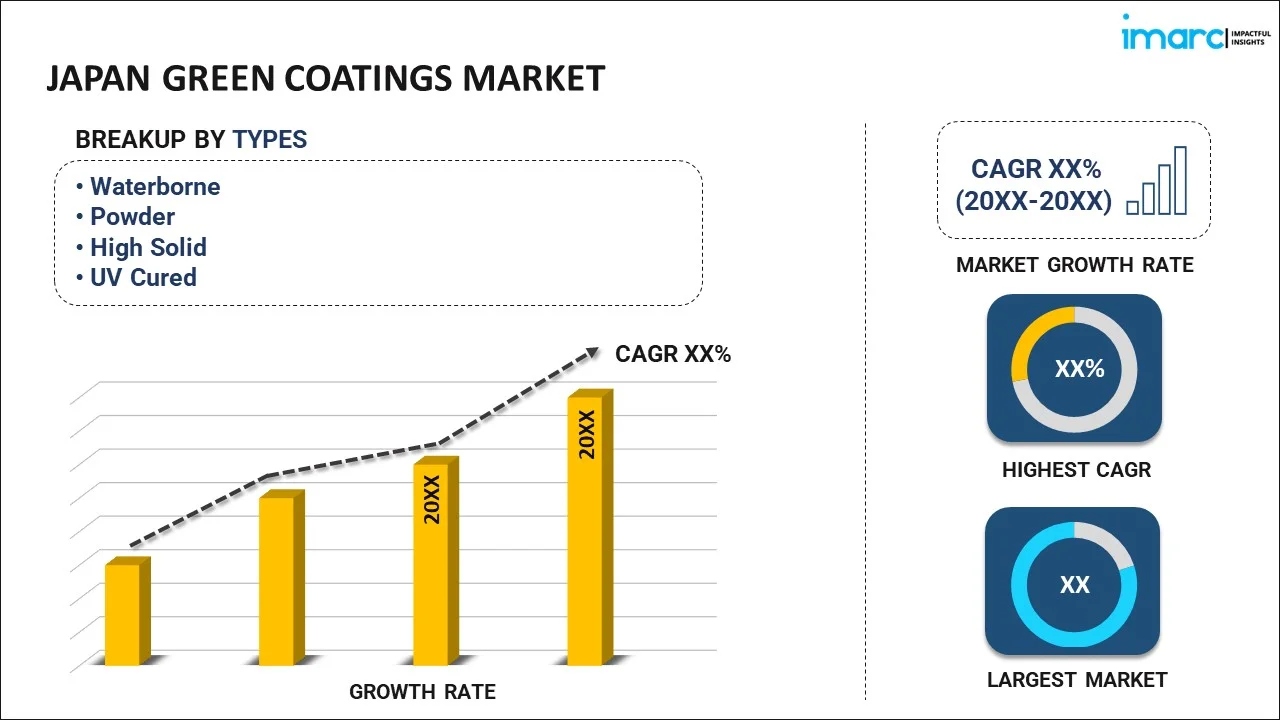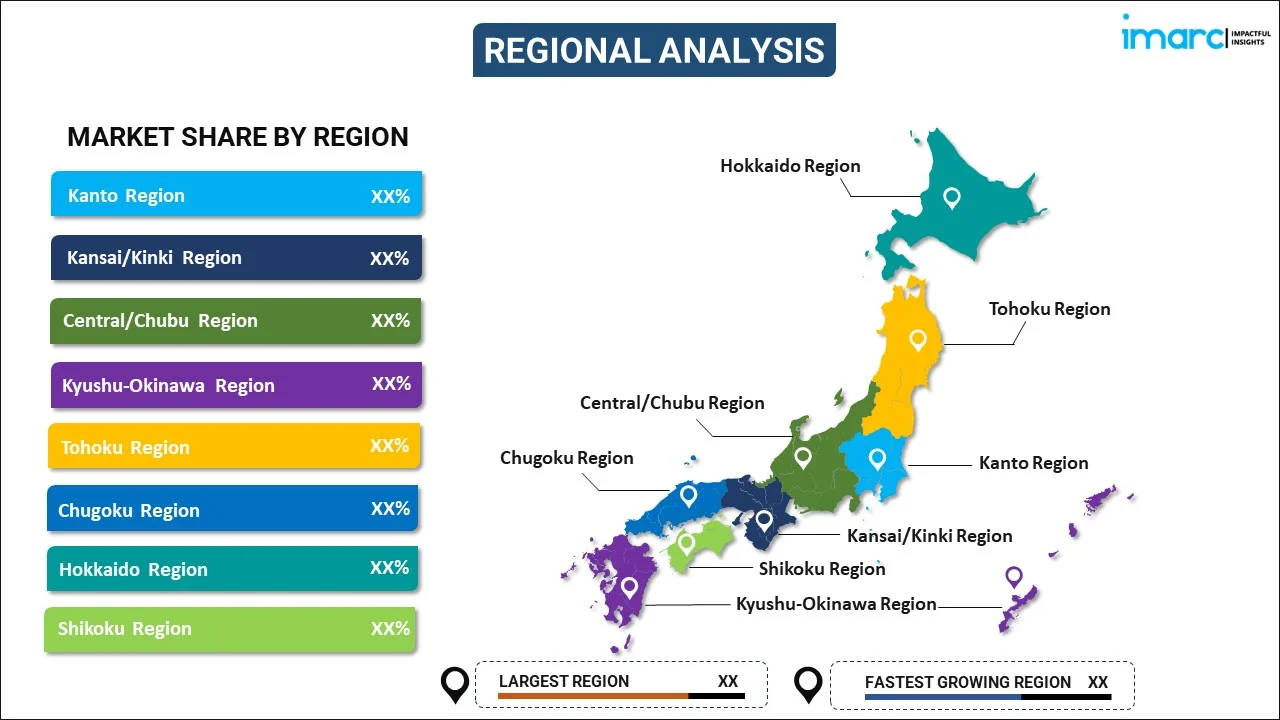
Japan Green Coatings Market Report by Type (Waterborne, Powder, High Solid, UV Cured), Application (Architectural Coatings, Industrial Coatings, Automotive Coatings, Wood Coatings, Packaging Coatings, and Others), and Region 2025-2033
Market Overview:
Japan green coatings market size reached USD 5.3 Billion in 2024. Looking forward, IMARC Group expects the market to reach USD 7.6 Billion by 2033, exhibiting a growth rate (CAGR) of 4.07% during 2025-2033. The market is being driven by significant factors, such as the widespread adoption of occupational health and safety precautions and the growing trend towards environmentally friendly construction and sustainable architectural practices.
|
Report Attribute
|
Key Statistics
|
|---|---|
|
Base Year
|
2024
|
|
Forecast Years
|
2025-2033
|
|
Historical Years
|
2019-2024
|
|
Market Size in 2024
|
USD 5.3 Billion |
|
Market Forecast in 2033
|
USD 7.6 Billion |
| Market Growth Rate 2025-2033 | 4.07% |
Green coatings refer to eco-friendly paints and finishes engineered to reduce harmful emissions, energy usage, and waste. In contrast to conventional coatings that frequently contain hazardous components like volatile organic compounds (VOCs), green coatings utilize water-based solvents and natural materials. This characteristic enhances safety for human health and diminishes their ecological footprint. The objective is to curtail or eliminate pollutants responsible for deteriorating air quality, ozone layer depletion, and climate change. Diverse sectors, such as automotive, construction, and furniture production, are adopting green coatings as a consequence of growing awareness concerning sustainability and rigorous environmental regulations. These coatings often offer additional functional advantages, including heightened longevity and resistance to corrosion, rendering them an increasingly favored option in both industrial and consumer applications. By embracing green coatings, businesses can ameliorate their environmental impact while upholding high-quality finishing standards.
Japan Green Coatings Market Trends:
In the Japan green coatings market, one of the most prominent drivers stems from the proliferation of stringent environmental regulations and policies on a wide scale. Governments worldwide are introducing measures that restrict the emission of volatile organic compounds (VOCs) and hazardous air pollutants (HAPs) arising from paints and coatings. Consequently, numerous sectors, including automotive, aerospace, and construction, are compelled to transition from conventional coatings to more environmentally friendly options. Simultaneously, the significance of occupational health and safety has soared across various industries. Conventional coatings often pose health hazards to workers due to noxious fumes and potential skin contact. Green coatings, characterized by their low VOC content and absence of toxic elements, offer a safer alternative. This health-driven consideration motivates businesses to shift to eco-friendly coatings, ensuring a safer work environment and reducing both immediate and long-term health-related expenditures. Furthermore, the heightened emphasis on sustainability throughout supply chains contributes to the market's growth. Additionally, the emerging trend towards green construction and sustainable architectural practices is expected to fuel the regional market over the forecasted period.
Japan Green Coatings Market Segmentation:
IMARC Group provides an analysis of the key trends in each segment of the market, along with forecasts at the country level for 2025-2033. Our report has categorized the market based on type and application.
Type Insights:

- Waterborne
- Powder
- High Solid
- UV Cured
The report has provided a detailed breakup and analysis of the market based on the type. This includes waterborne, powder, high solid, and UV cured.
Application Insights:
- Architectural Coatings
- Industrial Coatings
- Automotive Coatings
- Wood Coatings
- Packaging Coatings
- Others
A detailed breakup and analysis of the market based on the application have also been provided in the report. This includes architectural coatings, industrial coatings, automotive coatings, wood coatings, packaging coatings, and others.
Regional Insights:

- Kanto Region
- Kansai/Kinki Region
- Central/ Chubu Region
- Kyushu-Okinawa Region
- Tohoku Region
- Chugoku Region
- Hokkaido Region
- Shikoku Region
The report has also provided a comprehensive analysis of all the major regional markets, which include Kanto Region, Kansai/Kinki Region, Central/ Chubu Region, Kyushu-Okinawa Region, Tohoku Region, Chugoku Region, Hokkaido Region, and Shikoku Region.
Competitive Landscape:
The market research report has also provided a comprehensive analysis of the competitive landscape. Competitive analysis such as market structure, key player positioning, top winning strategies, competitive dashboard, and company evaluation quadrant has been covered in the report. Also, detailed profiles of all major companies have been provided.
Japan Green Coatings Market Report Coverage:
| Report Features | Details |
|---|---|
| Base Year of the Analysis | 2024 |
| Historical Period | 2019-2024 |
| Forecast Period | 2025-2033 |
| Units | Billion USD |
| Scope of the Report | Exploration of Historical Trends and Market Outlook, Industry Catalysts and Challenges, Segment-Wise Historical and Future Market Assessment:
|
| Types Covered | Waterborne, Powder, High Solid, UV Cured |
| Applications Covered | Architectural Coatings, Industrial Coatings, Automotive Coatings, Wood Coatings, Packaging Coatings, Others |
| Regions Covered | Kanto Region, Kansai/Kinki Region, Central/ Chubu Region, Kyushu-Okinawa Region, Tohoku Region, Chugoku Region, Hokkaido Region, Shikoku Region |
| Customization Scope | 10% Free Customization |
| Post-Sale Analyst Support | 10-12 Weeks |
| Delivery Format | PDF and Excel through Email (We can also provide the editable version of the report in PPT/Word format on special request) |
Key Questions Answered in This Report:
- How has the Japan green coatings market performed so far and how will it perform in the coming years?
- What has been the impact of COVID-19 on the Japan green coatings market?
- What is the breakup of the Japan green coatings market on the basis of type?
- What is the breakup of the Japan green coatings market on the basis of application?
- What are the various stages in the value chain of the Japan green coatings market?
- What are the key driving factors and challenges in the Japan green coatings?
- What is the structure of the Japan green coatings market and who are the key players?
- What is the degree of competition in the Japan green coatings market?
Key Benefits for Stakeholders:
- IMARC’s industry report offers a comprehensive quantitative analysis of various market segments, historical and current market trends, market forecasts, and dynamics of the Japan green coatings market from 2019-2033.
- The research report provides the latest information on the market drivers, challenges, and opportunities in the Japan green coatings market.
- Porter's five forces analysis assist stakeholders in assessing the impact of new entrants, competitive rivalry, supplier power, buyer power, and the threat of substitution. It helps stakeholders to analyze the level of competition within the Japan green coatings industry and its attractiveness.
- Competitive landscape allows stakeholders to understand their competitive environment and provides an insight into the current positions of key players in the market.
Need more help?
- Speak to our experienced analysts for insights on the current market scenarios.
- Include additional segments and countries to customize the report as per your requirement.
- Gain an unparalleled competitive advantage in your domain by understanding how to utilize the report and positively impacting your operations and revenue.
- For further assistance, please connect with our analysts.
 Inquire Before Buying
Inquire Before Buying
 Speak to an Analyst
Speak to an Analyst
 Request Brochure
Request Brochure
 Request Customization
Request Customization




.webp)




.webp)












